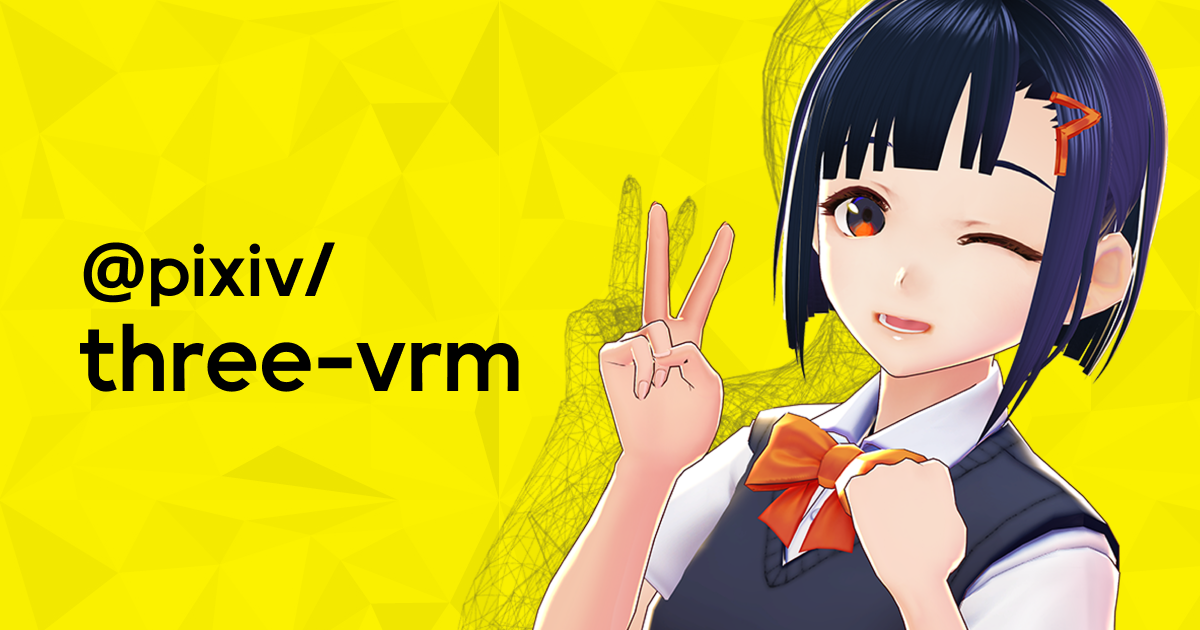@pixiv/three-vrmUtilisez VRM sur trois.js

Référentiel GitHub
Exemples
Documentations
Référence de l'API
Vous aurez besoin:
.module est ESM, sinon il est UMD et injecte ses modules en THREE.minVous pouvez importer toutes les dépendances via CDN comme jsdelivr.
< script type =" importmap " >
{
"imports" : {
"three" : "https://cdn.jsdelivr.net/npm/[email protected]/build/three.module.js" ,
"three/addons/" : "https://cdn.jsdelivr.net/npm/[email protected]/examples/jsm/" ,
"@pixiv/three-vrm" : "https://cdn.jsdelivr.net/npm/@pixiv/three-vrm@3/lib/three-vrm.module.min.js"
}
}
</ script >
< script type =" module " >
import * as THREE from 'three' ;
import { GLTFLoader } from 'three/addons/loaders/GLTFLoader.js' ;
import { VRMLoaderPlugin } from '@pixiv/three-vrm' ;
// ... Setup renderer, camera, scene ...
// Create a GLTFLoader - The loader for loading VRM models
const loader = new GLTFLoader ( ) ;
// Install a GLTFLoader plugin that enables VRM support
loader . register ( ( parser ) => {
return new VRMLoaderPlugin ( parser ) ;
} ) ;
loader . load (
// URL of the VRM you want to load
'/models/VRM1_Constraint_Twist_Sample.vrm' ,
// called when the resource is loaded
( gltf ) => {
// retrieve a VRM instance from gltf
const vrm = gltf . userData . vrm ;
// add the loaded vrm to the scene
scene . add ( vrm . scene ) ;
// deal with vrm features
console . log ( vrm ) ;
} ,
// called while loading is progressing
( progress ) => console . log ( 'Loading model...' , 100.0 * ( progress . loaded / progress . total ) , '%' ) ,
// called when loading has errors
( error ) => console . error ( error ) ,
) ;
// ... Perform the render loop ...
</ script >Voir le document Three.js si vous n'êtes pas encore familier avec trois.js: https://threejs.org/docs/#manual/en/introduction/creating-a-scene
Voir l'exemple du code complet: https://github.com/pixiv/three-vrm/blob/release/packages/three-vrm/examples/basic.html
Installez three et @pixiv/three-vrm :
npm install three @pixiv/three-vrm À partir de la V3, nous fournissons une compatibilité WebGpureRenderer. Pour utiliser trois VRM avec webgpaureder, spécifiez le MToonNodeMaterial compatible webgpu pour l'option materialType de MToonMaterialLoaderPlugin .
MToonNodeMaterial ne prend en charge que trois.js R167 ou version ultérieure. Le système nominal de trois.js est toujours en cours de développement, nous pouvons donc rompre la compatibilité avec les versions plus anciennes de trois.js plus fréquemment que les autres parties de trois VRM.
import { GLTFLoader } from 'three/addons/loaders/GLTFLoader.js' ;
import { MToonMaterialLoaderPlugin , VRMLoaderPlugin } from '@pixiv/three-vrm' ;
import { MToonNodeMaterial } from '@pixiv/three-vrm/nodes' ;
// ... Setup renderer, camera, scene ...
// Create a GLTFLoader
const loader = new GLTFLoader ( ) ;
// Register a VRMLoaderPlugin
loader . register ( ( parser ) => {
// create a WebGPU compatible MToonMaterialLoaderPlugin
const mtoonMaterialPlugin = new MToonMaterialLoaderPlugin ( parser , {
// set the material type to MToonNodeMaterial
materialType : MToonNodeMaterial ,
} ) ;
return new VRMLoaderPlugin ( parser , {
// Specify the MToonMaterialLoaderPlugin to use in the VRMLoaderPlugin instance
mtoonMaterialPlugin ,
} ) ;
} ) ;
// ... Load the VRM and perform the render loop ...Voir l'exemple du code complet: https://github.com/pixiv/three-vrm/blob/release/packages/three-vrm/examples/webgpu-dnd.html
Voir: contribution.md
Mit